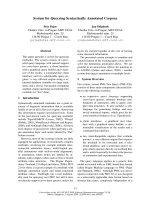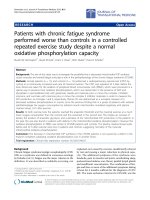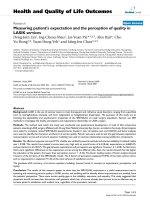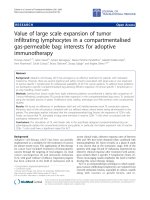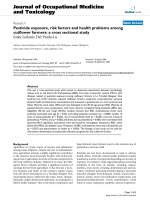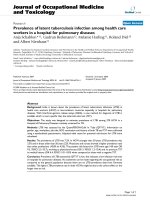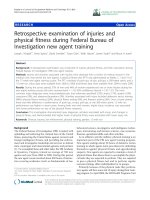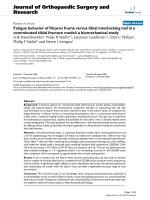Báo cáo toán học: " System for fast lexical and phonetic spoken term detection in a Czech cultural heritage archive" docx
Bạn đang xem bản rút gọn của tài liệu. Xem và tải ngay bản đầy đủ của tài liệu tại đây (508.71 KB, 11 trang )
RESEARCH Open Access
System for fast lexical and phonetic spoken term
detection in a Czech cultural heritage archive
Josef Psutka, Jan Švec, Josef V Psutka, Jan Vaněk, Aleš Pražák, LubošŠmídl and Pavel Ircing
*
Abstract
The main objective of the work presented in this paper was to develop a complete system that would accomplish
the original visions of the MALACH project. Those goals were to employ automatic speech recognition and
information retrieval techniques to provide improved access to the large video archive containing recorded
testimonies of the Holocaust survivors. The system has been so far developed for the Czech part of the archive
only. It takes advantage of the state-of-the-art speech recognition system tailored to the challenging properties of
the recordings in the archive (elderly speakers, spontaneous speech and emotionally loaded content) and its close
coupling with the actual search engine. The design of the algorithm adopting the spoken term detection
approach is focused on the speed of the retrieval. The resulting system is able to search through the 1,000 h of
video constituting the Czech portion of the archive and find query word occurrences in the matter of seconds.
The phonetic search implemented alongside the search based on the lexicon words allows to find even the words
outside the ASR system lexicon such as names, geographic locations or Jewish slang.
1 Introduction
The whole story of the cultural heritage archive that is
in focus o f our research and development effort began
in 1994 when, after releasing “Schindler’sList”,Steven
Spielberg was approached by many survivors who
wanted him to listen to their stories of the Holocaust.
Inspired by these requests, Spielberg decided to start the
Survivors of the Shoah Visual History Foundation
(VHF) so t hat as many survivors as possible could tell
their stories and have them saved. In his original vision,
he wanted the VHF (which later eventually became the
USC Shoah Foundation Institute [1]) to perform several
tasks, including collecti ng and preserving the Holocaust
survivors’ testimonies and cataloging t hose testimonies
to make them accessible.
The “col lecting” part of the mission has been c om-
pleted, resulting into what is believed to be the largest
collection of digiti zed oral history interviews on a single
topic: almost 52,000 interviews of 32 languages, a total
of 116,000 h of video. About half of the collection is in
English, and about 4,000 of English interviews (approxi-
mately 10,000 h, i.e., 8% of the entire archive) have been
extensively annotated by subject-matter experts
(subdivided into topically coherent segments, equipped
with a three-sentence summary and indexed with key-
words selected from a pre-defined thesaurus). This
annotation effort alone required approximately 150,000
h (75 person-years) and proved that a manual cataloging
of the entire archive is unfeasible at this level of
granularity.
This finding prompted the proposal of the MALACH
project (Multilingual Access to Large Spoken Archives–
years 2002-2007) whose aim was to use automatic
speech recognition (ASR) and information retrieval tech-
niques for access to the archive and thus circumvent the
need for manual annot ation and cataloging . There were
many partners involved in the project (see the project
website [2]), each of them possessing e xpertise in a
slightly different area of the speech processing and
information retrieval technology.
The goal of our laboratory was originally only to pre-
pare the ASR training data for several Central and East-
ern European languages (namely Czech, Slovak, Russian,
Polish and Hungarian); over the course of the project,
we gradually became involved in essentially all the
research areas, at least for the Czech language. After the
project has finished, we felt that although a great deal of
work has been done (see for example [3-5]), some of the
original project objectives still remained somehow
* Correspondence:
Department of Cybernetics, University of West Bohemia, Plzeň, Czech
Republic
Psutka et al. EURASIP Journal on Audio, Speech, and Music Processing 2011, 2011:10
/>© 2011 Psutka et al; licensee Springer. This is an Open Access article distributed under the terms of the Creative Commons Attribution
License ( which permi ts unrestricted use, distribution, and reproduction in any medium,
provided the original work is properly cited.
unfulfilled. Namely, there was still no complete end-to-
end system that would allow any user to type a query to
the system and receive a ranked list of pointers to the
relevant passages of the archived video recordings.
Thus, we have decided to carry on with the research
andfulfilltheMALACHprojectvisionsatleastforthe
Czech part of the archives. The portion of the testimo-
nies that was given in Czech language is small when
compared to the English part (about 550 testimonies,
1,000 h of video material), yet the amount of data is still
prohibitive for complete manual annotation (verbatim
transcription) and also poses a challenge when designing
a retrieval system that works in (or very near to) real
time.
The big advantage that our research team had when
building a system for searching the archive content was
that we had a complete control over all the modules
employed in the cascade, from the data preparation
works through the ASR engine to the actual search algo-
rithms. That way we were well aware of inherent weak-
nesses of individual components and able to fine tune
the modules to best serve the overall system
performance.
The following sections will thus describe the indivi-
dual system components, concentrating mainly on the
advancements that were achieved after the original
MALACH project was officially finished. But first let us
briefly introduce the specific properties of the Czech
language
2 Characteristics of the Czech language
Czech, as well as other Slavic languages (such as Russian
and Polish, to name the most known representatives), is
a richly inflected language. The declension of Czech
nouns, adjectives, pronouns and numerals has 7 cases.
Case, number (singular or plural) and gender (mascu-
line, feminine or neuter) are usually distinguished by an
inflectional ending; however, sometimes the inflection
affects t he word stem as well. The declension follow 16
regular paradigms but there are some additional
irregularities.
The conjugation of Czech verbs distinguishes first,
second and third person in both singular an d plural.
The third person in the past tense is marked by gender.
The conjugation is directed by 14 regular paradigms but
many verbs are irregular in the sense that they follow
different paradigms for different tenses.
Word order is grammatically free with no particular
fixed order for constituents marking subject, object, pos-
sesso r, etc. However, the standard order is subject-verb-
object. Pragmatic information and considerations of
topic and focus also play an important role in determin-
ing word order. Usually, topic precedes focus in Czech
sentences.
Inordertomakealanguagewithsuchfreeword
order understandable, the extensive use of agreement is
necessary. The strongest agreement is between a noun
and its adjectival or pronominal attribute: they must
agree in gender, number and case. There is also agree-
ment between a subject (expressed by a noun, pronoun
or even an adjective) and its predicate verb in gender
and number, and for pronouns, also in person. Verbal
attributes must agree in number and gender with its
related noun, as well as with its predicate verb (double
agreement). Possessive pronouns exhibit the most com-
plicated type of agreement–in addition to the above
mentioned triple attributive agreement with the pos-
sessed thing, they must also agree in gender and num-
ber with the possessor. Objects do not have to agree
with their governing predicate verb but the verb deter-
mines their case and/or preposition. Similarly, preposi-
tions determine the case of the noun phrase following
them [6].
It stems from the highly inflectional nature of the
Czech language that the size of the ASR lexicon g rows
quite rapidly and the ASR decoder must be designed in
such a way that it is able to cope with large vocabul-
aries. Our recognition engine is indeed able to handle a
lexicon with more than 500 thousa nd entries [7]. Unlike
in the case of Turkish or Finnish, where the problem of
vocabulary growth caused by agglutination was success-
fully addressed b y decomposing words into morphemes
[8], similar attempts for Czech have brought inconclu-
sive results [9].
An interesting phenomenon occurring in the Czech
languageisaconsiderabledifferencebetweenthewrit-
ten form of the language (Standard or Literary Czech)
and the spoken form (Common Czech). This difference
occurs not onl y on t he lexical level (usage of German-
isms and Anglicisms), but also on the phonetic and
morphological level. Some of the differences can even
be formalized (see for example [10]). We had to address
this issue during the development of both acoustic and
language models (see the “Language model” section
below).
3 Automatic speech recognition
3.1 Data preparation
The speech contained in the testimonies is very specific
in many aspects, owing mostly to the very nature of the
archive. The speakers are of course elderly (note that
the recor ding started in 1995), and due to the character
of their stories, their speech is often very emotional and
contains many disfluences and non-speech events such
as crying or whimpering. The speaking rate also varies
greatly depending on the speaker, which again is fre-
quently a n issue related to age (some interviewees were
so old that they struggled with the mere articulation,
Psutka et al. EURASIP Journal on Audio, Speech, and Music Processing 2011, 2011:10
/>Page 2 of 11
while others were still at the top of their rhetorical abil-
ities) and/or the language environment where the speak-
ers spent the last decades (as those living away from the
Czech Republic naturally stopped to sear ch for the cor-
rect expression more often).
Consequently, the existing annotated speech corpora
were not suitable for training of the acoustic models,
and we have to first prepare the data by transcribing a
part of the archived testimonies.
We have randomly selected 400 different Czech testi-
monies from the archive and t ranscribed 15-min seg-
ment from each of them, starting 30 min from the
beginning of the interview (thus getting past th e biogra-
phical questions and initial awkwardness). Detailed
description of the transcription format is given in [11];
let us only mention that in addition to the lexical tran-
scription, the transcribers also marked several non-
speech events. That way we have obtained 100 h o f
training data that should be represent ative of the major-
ity of the speakers in the archive. Another 20 testimo-
nies (10 male and 10 female speakers) were transcribed
completely for the ASR development and test purposes.
3.2 Acoustic modeling
The acoustic models in our system are based on the
state-of-the-art hidden Markov models (HMM) architec-
ture. Standard 3-state left-to-right models with a mix-
ture o f multiple Gaussians in each state are used.
Triphone dependenc ies (inc luding the cross-wor d ones)
are taken into account. The speec h data w ere parame-
terized as 15-dimensional PLP cepstral features includ-
ing their delta and delta-delta derivatives (resulting into
45-dimensional feature vectors) [12]. These feature s
were computed at the rate of 100 frames per second.
Cepstral mean subtraction was applied per sp eaker. The
resulting triphone-based model was trained using HTK
Toolkit [13]. The number of clustered states and the
number of Gaussians mixtures per state were optimized
using a development test set and had more than 6 k
states and 16 mixtures per state (almost 100 k
Gaussians).
As was already mentioned, non-speech events appear-
ing in spontaneous speech of survivors were also anno-
tated. We used these annotated events to train a
generalized model of silence in the following manner:
We took the sets of Gaussian mixtures from all the
non-speech event m odels including the standard model
for a long pause (silence–sil–see [13]). Then we
weighted those sets according to the state occupation
statistics of the corresponding models and compounded
the weighted sets together in order to create a robust
“silence” model with about 128 Gaussian mixtures. The
resulting model was incorporated into the pronunciation
lexicon, so that each phonetic baseform in the lexicon is
allowed to have either the short pause model (sp)orthe
new robust sil model at the end.
The described technique “catches” most of standard
non-speech events appearing in running speech very
well, which improved the recognition accuracy by elimi-
nating many of the insertion errors.
The state-of-the-art speaker adaptive training and dis-
criminative training [14] algorithms were employed to
further improve the quality of the acoustic models.
Since the speaker identities were known, we could s plit
the training data into several clusters (male interviewees,
female interviewees and interviewers) before the actual
discriminative training adaptation (DT–see [15] for
details) to enhance the method’s effectiveness.
3.3 Language modeling
The language model used in the fina l system draws from
the experience gained from the extensive experiments per-
formed over the course of the MALACH project [16].
Those experiments revealed that even though the tran-
scripts of the acoustic model training data constitute a
rather small corpus from the lang uage model ing point of
view (approximately one million tokens), they are by far
more suitable for the task than much larger, but “out-of-
domain” text corpora (comprising, for example, newspaper
articles). However, if a more sophisticated technique than
just throwing in more data is used for extending the lan-
guage model training corpus, it is possible to further
improve the recognition performance. We have also found
out that the spontaneous nature of the data brought up a
need for careful handling of colloquial words that are
abundant in casual Czech speech. It turned out tha t the
best results were achiev ed when the colloquial forms are
employed in the acoustic modeling stage only and the
standardized forms are used as the “surface” forms in the
lexicon of the decoder and in the language model estima-
tion process (see [17] for details). In other words, t he
recognizer produces text in the standardized word forms,
while the colloquial variants are treated as pronunciation
variants inside the decoder lexicon.
In concordance with those findings, we have trained
two basic language models. The first one was estimated
using only the acoustic training set transcripts, and the
second was trained from the selection of t he Czech
National Corpus (CNC). This corpus is relatively large
(approximately 400 M words) and extremely diverse.
Therefore, it was impractical to use the whole corpus,
and we investigated the possibility of using automatic
methods to select sentences fro m the CNC that are in
some way similar to the sen tences in the training set
transcriptions. The method that we have used is based
on [18] and employs two unigram language models–one
of them (P
CNC
) is estimated from the CNC collection,
and the other (P
Tr
) was estimated from the acoustic
Psutka et al. EURASIP Journal on Audio, Speech, and Music Processing 2011, 2011:10
/>Page 3 of 11
training set transcripts. A likelihood ratio test was
applied to each sentence in the CNC, using a threshold
t: a sentence s from the CNC was added to the filtered
set (named CNC-S) if P
CNC
(s)<t.P
Tr
(s). This is a simple
way of assessing whether sentences from the CNC are
closer to the testimony transcriptions than to the bulk
of the CNC corpus itself. The test threshold effectively
allowed us to determine the size of selected sub-corpus
CNC-S. Gradually decreasing the threshold yields smal-
ler and smaller subcorpora that, ideally, are more and
more similar to the testimony transcriptions. A thresh-
old of 0.8 created a CNC-S containing about 3% of the
CNC (approximately 16 M tokens). Merging the lexi-
cons from bo th CNC-S and acoustic training set tran-
scripts and consequently interpolating corresponding
language models yielded WER improvement of 2% abso-
lute [16]. The interpolation ration 3:1 (transcriptions to
the CNC-S) was used in the presented system as this
factor gave the best recognition perfor mance in the
experiments [16]. The lexicon of the resulting trigram
language model contains 252 k words (308 k pronuncia-
tion variants), 3.6 M bigrams and 1.3 M trigrams. Lan-
guage models were estimated using the SRI Language
Modeling Toolkit (SRILM) [19] employing the modified
Kneser-Ney smoothing method [20].
3.4 Speech recognition: generation of word and phoneme
lattices
There was an important issue to solve even before the
actual speech recognition process started. That is, what
speech signal should be actually recognized. The pro-
blem was that the signal extracted from the archive
video recordings was stereo , one channel containing the
speech of the interviewer and the other the speech of
the interviewee. However, there were frequent echoes
despite the fact that the speakers were wearing lapel
microphones. This was particularly challenging in the
event of cross-talking when the speech of both dialogue
participants was mixed together in both channels and
we have to design an algorithm for separating the
speech that was based on the levels of energy. Also, to
save the computational power and storage, we have
omitted from recognition all the portions of the signal
that did not contain any speech.
Then the processed signal was streamed into our in-
house ASR system [21] that was used in two recognition
passes. The first pass employs the trigram language
model described in Section 3.3 and clustered DT
adapted acoustic models that are automatically gradually
adapted to each individual speaker. This unsupervised
iterative speaker adaptation algorithm employs both
fMLLR and MAP methods (see [22] for details) and
uses for adaptation only the speech segments with confi-
dence measure (expresse d in o ur case in terms o f
posterior probabilities) exceeding 0.99, thus ensuring
reliable estimates of the transformation matrices.
The speaker adapted models are then employed in the
second pass to generate the lattices to be used in the
search engine. In order to help the search algorithm, the
lattices were equipped with a confidence scores com-
puted as the posterior probabilities using the forward-
backward algorithm. Both word and phoneme lattices
were generated in this manner, important distinction
being that the phoneme recognizer did not use any lan-
guage model for the lattice generation.
The parameters of the ASR system were optimized on
the development data (complete testimonies of 5 male
and 5 female speakers). The recognition results listed in
the Table 1 show the (one-best) phoneme recognition
accuracy as well as recognition accuracy of the word-
based system. This accuracy was computed on the test
set comprising another 5 male’sand5female’s testimo -
nies. The total number of words in the test set was
63,205 with 2.39% out-of-vocabulary (OOV) words.
Note that the accuracy of the Czech ASR reported just
after the MALACH project completion was about 10%
absolute lower (see [23]).
Using the lattices for searching is an important step
away from the oversimplifying approach to speech
retrieval on the same archive that was adopted by all
teams participating in the CLEF campaign CL-SR tracks
in 2006 [24] and 2007 [25], where the problem of
searching speech was reduced to a classic document-
oriented retrieval by using only the one-best ASR output
and artificially creating “do cuments” by sliding a fixed-
length window across the resulting text stream. The lat-
tice-based approach, on the other hand, allows to
explore the alternative hypotheses about the actual
speech content–note that the o ne-best error rate is still
rather high. Dropping the artificial segmentation into
the (quite long) fixed-length documents then enables
much more finely grained time resolution when looking
for the relevant passages. This could save the users of
the search engine a lot of browsing through unrelevant
bits of the archive. Furthermore, the presence of pho-
neme lattices enables for searching of out-of-vocabulary
terms (see more details in the following sections).
4 Indexing and searching
The general goal of the search system is rather clear and
well defined. The task is to:
Table 1 Test set ASR results
Recognition units Accuracy (%)
Words 72.89
Phonemes 70.38
Psutka et al. EURASIP Journal on Audio, Speech, and Music Processing 2011, 2011:10
/>Page 4 of 11
1. Identify appropriate replay p oints in the record-
ings–that is, the moments where the discussion
about the queried topics starts.
2. Present them in some user-friendly manner to the
searcher.
However, there are m any ways to approach this tasks.
One of them is essentially a standard text retrieval that
was used in the aforementioned CLEF campaign. The
approach adopted in the presented work conforms to the
definition of spoken term detection (STD) as given for
example in [26]. This method does not care about the
somehow abstract topic of the document (like traditional
IR does or at least claims to) but instead it just looks for
the occurrences of query terms. Unlike the keyword spot-
ting methods, the STD uses a pre-built index for the
actual query searching, making the search faster; it also
means that the queries need not to be known beforehand.
4.1 Indexing
Separate indexes were built from the word and the pho-
neme lattices.
4.1.1 Word index
The construction of the word index was the easier task.
In the word lattice, every arc r epresents one word and
theweightofthearcdenotestheconfidencemeasure
(expressed as posterior probability) associated with the
given word. In order to reduce t he size of the resulting
index, two stages of pruning were applied. The first
stage takes place at the beginning when all the arcs
whose poster ior probability is lower than a threshold θ
w
are discarded (θ
w
= 0.05). Each of the remaining arcs is
represented by a 5-tuple:
(
start t, end t, word, score, item id
)
where start_t and end_t are the beginning and end
time, respectively, word is the word (ASR lexicon item)
associated with the arc, score is the aforementioned pos-
terior probability and finally item_id is the identifier of
the original video file (start_t and end_t represent the off-
set relative to the beginning of this file). The index is
further pruned by removing similar items. If there are
two arcs labeled with the same word that are either over-
lapping or are being less than Δt
w
apart (Δt
w
is set to 0.5
s), only the arc with the higher score is retained. It fol-
lows from the description that the indexing procedure
omits the structural properties of the original lattice but,
on the other hand, makes a compact and effic ient repre-
sentation of the recognized data. The total number of
items in the resulting word index is approximately 12 M.
4.1.2 Phoneme index
The building of the phoneme index is more compli-
cated. Having single phones as the index items was
foundtobeineffectiveasitproducedalotoffalse
alarms. Therefore, the proposed algorithm traverses the
lattice and collects triplets of adjacent arcs (i.e., trigrams
of the subsequent phonemes) and immediately discards
those trigrams that meet any one of the following condi-
tions:
• one or more of the phonemes is a silence
• any two adjacent phonemes are identical
• posterior probability of any phoneme is lower than
a threshold θ
p
(θ
p
= 0.05)
Each remaining trigram is then labeled with appropri-
ate start and end time and with a combined score that
is computed as the geometric mean of posterior prob-
abilities of the individual phonemes. The geometric
mean is used because it assigns, in comparison with the
arithmetic mean, much lower probabil ity to th e trigrams
where one of the phonemes has distinctively lower con-
fidence score. This leads t o the desirable elimination of
the least promising paths in the lattice. The usage of
geometric mean also facilitates the computation as the
posterior probabilities of the lattice arcs are given in the
logarithm form.
In the next step of the indexing algorithm, all the tri-
grams whose combined score falls below a threshold θ
C
(θ
C
=0.1)arediscarded.Theremaining trigrams are
then ordered on the time axis–if there are more triplets
labeled with the same phoneme trigram withi n the win-
dow of the length Δt
p
(Δt
p
= 0.03s), only the triplet with
the highest score is included in the index. All the algo-
rithm steps naturally again cause the structural proper-
ties of the lattice to be omitted. Finally, the same 5-
tuples representing each remaini ng arc as in the case of
the word index are stored in the database, and only now
the word is replaced with the numeric ID representing
given phoneme trigram. There are approximately 63 k
different phoneme trigrams in the final index, and the
number of items exceeds 88 M.
4.2 Searching
When searching the word index, all possible phonetic
transcriptions (phoneme representation s) of the query
word are found in the lexicon. Then those phoneme
sequences are mapped back to all corresponding word
forms from the lexicon. This allows to search simulta-
neously, for example, for both the English a nd Czech
spelling variants of a word (e.g., Shoah and the Czech
transliteration Šoá). The system also makes po ssible to
search for all inflected forms of a given word. If this fea-
ture is enabled, the lemma is also found for each of the
query words. Consequently, the set of query words is
extended with all possible word forms found in the voca-
bulary for each of the lemmas (these linguistic processing
steps are done using a method described in [27]).
Psutka et al. EURASIP Journal on Audio, Speech, and Music Processing 2011, 2011:10
/>Page 5 of 11
Search in the phoneme index takes place when the
query word is an OOV or when it is forced by the user.
The query word is again transcribed into a sequence of
phonemes (we have a rule-based system for phonetic
transcription, and thus, the phoneme representation can
be obtained easily even for an OOV word). Then for
each of the phoneme strings, the following steps are
performed:
1. The consecutive phone trigrams are generated–e.
g., the word ‘válka’ (the war) is decomposed into ‘v
aa l’, ‘aa l k’ and ‘lka’.
2. All those trigrams are simultaneously searched for
in the phoneme index and ordered according to the
video file ID and the starting time.
3. For each video file ID, the found trigrams are
clustered together on the time axis so that the time
gap between clusters is at least equal to θ
search
(θ
search
= 0.2s).
4. Every such cluster is then assigned a score that is
computed as
score
comb
=
(
1 − λ
)
score
ACM
+ λ score
hi
t
where score
ACM
is the arithmetic mean of scores of
the phoneme index items in the cluster and score
hit
is the ratio betwee n the number of trigrams that
were correctly found in the given cluster and the
number of trigrams representing the searched word.
This implies that the algorithm does not strictly
require the pre sence of all trigrams from the query.
The interpolation coefficient was tuned using dev el-
opment data and consequently set to l =0.6.The
score
comb
then serves as the ultimate relevance score.
The presented system also provides some functionality
that allows searching for phrases of sever al words. Every
word in the query phrase can be marked as either man-
datory or optional. The search algorithm then:
1. Looks for individual words and orders the results
on the time axis (separately for each video file)
2. Clusters the results so that the time gap between
the clusters is at least θ
phrase-search
=10s
3. Discards all clusters that do not contain all man-
datory words.
4. Assigns e ach cluster a score that is computed as
the arithmetic mean of the individual word scores.
4.3 GUI description and HW/SW implementation details
The graphical user interface is designed with the IT
non-professional in mind and is therefore as simple as
possible (see the Figure 1). In the lower left corner, it
has a text box for entering query word/phrase and
check boxes for selecting the channels to be searched
(interviewer and/or interviewee). The query can be mod-
ified using a set of simple operators–the plus sign is
used to mark mandatory words and enclosing a word in
parentheses tells the search engine that it should look
for the exact word form only (i.e., the default expansion
to all possible word forms is disabled). The retrieved
results are show n in t he right half of the GUI window.
Each item shows the unique video file ID, the channel,
the speaker’s name, the exact form of the word or the
phrase that was found, the time when the word/phrase
occurs and the relevance score. The upper left corner
then contains the multimedi a player with the usual con-
trols that allows to immediately replay any video file
listed in the result window, starting several second prior
to the query occurrence.
The search engine was implemented with a specific
focus on the retrieval speed and on the system scal-
ability. We also wanted to run the search algorithm on
a portable equipment so that we can disseminate the
research results at various forums. Thus, we have
decided to employ SQL database server architecture
for storage of both word and phoneme indexes in
ordertoensurefastsystemresponse(astheSQL
access algorithms are well optimized for speed). The
speed is further improved by storing the database on
the 64 GB SSD drive inst ead of the con ventio nal HDD.
Other parameters of the hardware are rather moderate
(HP EliteBook 8730w with Intel
®
Core™2 Duo Proces-
sor 2.80 GHz, 4 GB RAM). The video files with the
actual testimonies are stored on two external USB
hard drives (1 TB each). The system architecture sup-
ports remote access to the database which enables to
run the search algorithm on different portions of the
archive in parallel using several CPUs and therefore
allows to scale the system to much larger archives
rather seamlessly.
5 Evaluation
The quality of the STD was evaluated using two sets of
queries whose occurrences have been manually anno-
tated in the test portion of the video data. The first set
(SetIn) contains 20 words that are present in the ASR
lexicon (and consequently also in the word index); the
total number of occurrence of SetIn words in the test
data is 374. The second set (SetOut) consists of 108
wordsthatarenotincludedintheASRlexiconand
thus can be found only using the phoneme-based
search; those words occur in the test data 414 times i n
total. The detection results are shown in Figure 2 (DET
plot). In addition, the figure-of-merit (FOM) and equal-
error-rate (EER) values are given in Table 2.
Psutka et al. EURASIP Journal on Audio, Speech, and Music Processing 2011, 2011:10
/>Page 6 of 11
Figure 1 Screenshot of a GUI window.
1
2
5
10
20
40
60
80
90
.001 .004 .01 .02 .05 .1 .2 .5 1 2 5 10 20 40 60 8
0
Miss probability [%]
False Alarm
p
robabilit
y
[%]
Random Performance
Word Search
Phonetic Search
1best Search
Figure 2 Detection error tradeoff (DET) plot.
Psutka et al. EURASIP Journal on Audio, Speech, and Music Processing 2011, 2011:10
/>Page 7 of 11
The plots reveal that the number of false alarms is
essentially the same for search in 1-best ASR output (i.
e., the situation when only the best path through the lat-
tice is retained) and search in the word lattice, up to the
point where the 1-best system is not able to provide any
more correct hits and the lattice search becomes the
clear winner. Searching in the phoneme lattice, on the
other hand, produces substantially more false alarms
than both the word-based algorithms, yet its big advan-
tage lies in the ability to search for the words that are
missing from the ASR lexicon. Those missing words are
often some rare personal and place names and just as
they are underrepresented in t he language model train-
ing data, they are also very important to the searchers
of the collection [28] (in fact, two-thirds of the requests
specified named entities in the preliminary MALACH
user studies). The phonetic search mode also allows
users to type only an “approximate” spelling of the
searched query which is extremely helpful especially in
the case of foreign words or even words that are trans-
literated from different alphabets and it is not clear
what spelling variant (if any) appears in the ASR lexicon.
OneofthekeyconsiderationsofourSTDengine
design was the focus on the quick response of the sys-
tem. The following section is therefore devoted to the
evaluation of the retrieval speed. Figure 3 depicts the
histograms of search times for both the lexical and pho-
netic searches (we define thesearchtimeastheperiod
between entering the query and the moment when all
the found segments are presented to the user). It shows
that the statistical mode of the lexical search time is
only 0.5 s and the vast majority of the searches is fin-
ished in less than 5 s. For the search in the phonetic lat-
tices, the statistical mode is 7.5 s and the majority of the
searches take less than 20 s which we find still very rea-
sonable. Figure 4 further reveals t hat in the case of
Table 2 Spoken term detection results
SetIn (lexicon words) SetOut (OOVs)
Lattice type FOM (%) EER (%) FOM (%) EER (%)
1-best ASR 79.60 20.86 - -
Word lattice 93.73 19.79 - -
Phoneme lattice 73.69 45.99 75.41 52.17
0
0.05
0.1
0.15
0
.
2
0 10 20 30 40 50 6
0
Relative frequency
Search time [s]
Phonetic search
Word search
Figure 3 Histogram of search times.
Psutka et al. EURASIP Journal on Audio, Speech, and Music Processing 2011, 2011:10
/>Page 8 of 11
searching the word lattices, the search time is more or
less linear to the number of retrieved results, It is
because retrieving one word hit requires just a single
SQL query that takes always the same time and no
further processing is necessary. On the other hand, the
phonetic search time dispersion that could be observed
in Figure 5 is attributed to the fact that large number of
individual phoneme trigrams is retrieved first for all
queries and those trigrams are then clustered and fil-
tered to produce the list of relevant results. The search
time then depends mainly on the query length (see Fig-
ure 6) because this is the factor that influences the
number of individual phoneme trigrams that are
returned in the first retrieval step.
6 Conclusions
The paper introduced the system for searching sponta-
neous speech data that was built in an effort taken to
advance toward the ultimate goals of the MALACH pro-
ject. The novelty of our contributi on lies mainly in the
fact that we have managed to develop end-to-end sys-
tem that incorporates all the state-of-the-art compo-
nents necessary for processing audio archives to the
form that is directly searchable in real time. The metho-
dology developed within the research effort described in
this paper will be directly applicable in the related tasks
of indexing various audiovisual archives. The dema nd
for such a technology is currently in the upswing as the
volume of unstructured audio data available in digital
form is growing with an unprecedented pace. Actually,
we are already trying to a ddress a similar research issue
in a joint project with Czech Television (national public
broadcaster) that needs a technology for assisted catalo-
ging of its evergrowing archive.
Both the objective evaluation presented in this paper
and the positive feedback that the researchers were
receiving during several live demonstrations suggest that
the work w as successful and that we have created fast
and efficient system. It could make the Czech interviews
more accessible to the historians, filmmakers, students
and of c ourse also to the general public. Negotiations
concerning the system deployment in the Malach Center
for Visual History in Prague are currently taking place,
as well as the preparation of the joint project with the
USC Shoah Foundation Institute that would aim at the
development of the English version of the system.
0
5
10
15
20
0 1000 2000 3000 4000 500
0
Search time [s]
Number of search results
Figure 4 Dependency of a lexical search time on a number of search results.
Psutka et al. EURASIP Journal on Audio, Speech, and Music Processing 2011, 2011:10
/>Page 9 of 11
0
5
10
15
20
0 100 200 300 400 50
0
Search time [s]
Number of search results
Figure 5 Dependency of a phonetic search time on a number of search results.
0
10
20
30
40
50
2 4 6 8 10 12 14 16
Average search time [seconds]
Searched word len
g
th [# chars]
Figure 6 Dependency of a phonetic search time on a searched term length.
Psutka et al. EURASIP Journal on Audio, Speech, and Music Processing 2011, 2011:10
/>Page 10 of 11
Endnotes
a
The Czech speech resources were scarce anyway in the
time when the MALACH project started, not to men-
tion their domain incompatibility.
b
Some keyword spot-
ting algorithms build specific acoustic models for ea ch
query and then process entire archive using those mod-
els, which is of course intractable in real time.
c
Note
that Czech is a language with highly inflectional
morphology.
Acknowledgements
This work was supported by the Grant Agency of the Czech Academy of
Sciences project No. 1QS101470516 and the Ministry of Education, Youth
and Sports of the Czech Republic project No. LM2010013 (LINDAT-Clarin).
The authors would like to thank the USC Shoah Foundation Institute for
assistance with getting all the necessary archive files and also for inviting us
to present our results at the USC Digital Access, Outreach, and Research
Conference in March 2010.
Competing interests
The authors declare that they have no competing interests.
Received: 26 July 2011 Accepted: 5 December 2011
Published: 5 December 2011
References
1. USC Shoah Foundation Institute (2011)
2. MALACH Multilingual Access to Large Spoken Archives http://malach.
umiacs.umd.edu/ (2007)
3. W Byrne, D Doermann, M Franz, S Gustman, J Hajič, D Oard, M Picheny, J
Psutka, B Ramabhadran, D Soergel, T Ward, WJ Zhu, Automatic recognition
of spontaneous speech for access to multilingual oral history archives. IEEE
Trans Speech Audio Process. 12(4), 420–435 (2004). doi:10.1109/
TSA.2004.828702
4. P Ircing, J Psutka, J Vavruška, What can and cannot be found in Czech
spontaneous speech using document-oriented IR methods–UWB at CLEF
2007 CL-SR track, in Advances in Multilingual and Multimodal Information
Retrieval, Lecture Notes in Computer Science, vol. 5152, ed. by Peters C,
Jijkoun V, Mandl T, Müller H, Oard D, Peńas A, Petras V, Santos D (Springer,
Berlin, 2008), pp. 712–718. doi:10.1007/978-3-540-85760-0_90
5. P Ircing, JV Psutka, J Psutka, Using Morphological Information for Robust
Language Modeling in Czech ASR System. IEEE Trans Audio Speech Lang
Process. 17(4), 840–847 (2009)
6. M Grepl, Z Hladká, M Jelínek, P Karlík, M Krčmová, M Nekula, Z Rusínová, D
Šlosar, Příruční mluvnice češtiny (NLN, Praha, 1996)
7. A Pražák, P Ircing, J Švec, J Psutka, Efficient combination of N-gram
language models and recognition grammars in real-time LVCSR decoder, in
Proceedings of ICSP 2008, China, 587–591 (2008)
8. M Creutz, T Hirsimäki, M Kurimo, A Puurula, J Pylkkönen, V Siivola, M
Varjokallio, E Arisoy, M Saraçlar, A Stolcke, Morph-based speech recognition
and modeling of out-of-vocabulary words across languages. ACM Trans
Speech Lang Process. 5,1–29 (2007)
9. W Byrne, J Hajič, P Ircing, P Krbec, J Psutka, Morpheme based language
models for speech recognition of Czech, in Text, Speech and Dialogue,
Lecture Notes in Computer Science, vol. 1902, ed. by Sojka P, Kopecek I, Pala
K (Springer, Berlin, 2000), pp. 139–162. doi:10.1007/3-540-45323-7_24
10. P Sgall, J Hronek, A Stich, J Horecký, (eds.), Variation in Language: Code
Switching in Czech as a Challenge for Sociolinguistics (John Benjamins,
Amsterdam, 1992)
11. J Psutka, J Hajič, W Byrne, The development of ASR for Slavic languages in
the MALACH project, in Proceedings of ICASSP 2004, Montreal, Canada,
749–752 (2004)
12. H Hermansky, Perceptual linear predictive (PLP) analysis of speech. J Acoust
Soc Am. 87(4), 1738–1752 (1990). doi:10.1121/1.399423
13. S Young, D Kershaw, J Odell, D Ollason, V Valtchev, P Woodland, The HTK
Book (Entropic, Cambridge, 2000) />14. D Povey,
Discriminative Training for Large Vocabulary Speech Recognition,
PhD thesis (University of Cambridge, Cambridge, 2003).
15. J Vaněk, J Psutka, J Zelinka, A Pražák, J Psutka, Discriminative training of
gender-dependent acoustic models, in Text, Speech and Dialogue, Lecture
Notes in Computer Science, vol. 5729, ed. by Ma-toušek V, Mautner P
(Springer, Berlin, 2009), pp. 331–338. doi:10.1007/978-3-642-04208-9_46
16. J Psutka, P Ircing, JV Psutka, V Radová, W Byrne, J Hajič, J Mírovský, S
Gustman, Large vocabulary ASR for spontaneous Czech in the MALACH
project, in Proceedings of Eurospeech 2003 Geneva, Switzerland, 1821–1824
(2003)
17. J Psutka, P Ircing, J Hajič, V Radová, JV Psutka, W Byrne, S Gustman, Issues
in annotation of the Czech spontaneous speech corpus in the MALACH
project, in Proceedings of LREC 2004 Lisbon, Portugal, 607–610 (2004)
18. R Iyer, M Ostendorf, H Gish, Using out-of-domain data to improve in-
domain language models. IEEE Signal Process Lett. 4(8), 221–223 (1997).
doi:10.1109/97.611282
19. A Stolcke, SRILM–an extensible language modeling toolkit, in Proceedings of
ICSLP 2002, Denver, USA, 901–904 (2002)
20. SF Chen, J Goodman, An Empirical Study of Smoothing Techniques for
Language Modeling. Technical Report TR-10-98 (Computer Science Group,
Harvard University, Cambridge, MA, 1998)
21. A Pražák, L Müller, JV Psutka, J Psutka, LIVE TV SUBTITLING–fast 2-pass
LVCSR system for online subtitling, in Proceedings of SIGMAP 2007,
Barcelona, Spain, 139–142 (2007)
22. Z Zajíc, L Machlica, L Müller, Refinement approach for adaptation based on
combination of MAP and fMLLR, in Text, Speech and Dialogue, Lecture Notes
in Computer Science, vol. 5729, ed. by Matoušek V, Mautner P (Springer,
Heidelberg, 2009), pp. 274–281. doi:10.1007/978-3-642-04208-9_39
23. P Ircing, JV Psutka, J Psutka, A Pražák, Z Tychtl, Automatic speech
recognition and information retrieval techniques for facilitating access to
video archives of cultural heritage, in Proceedings of DHMS 2008, Athens,
Greece, 323–328 (2008)
24. P Ircing, L Müller, Benefit of proper language processing for Czech speech
retrieval in the CL-SR task at CLEF 2006, in Evaluation of Multilingual and
Multi-modal Information Retrieval, Lecture Notes in Computer Science, vol.
4730, ed. by Peters C, Clough P, Gey F, Karlgren J, Magnini B, Oard D, de
Rijke M, Stempfhuber M (Springer, Berlin, 2007), pp. 759–765. doi:10.1007/
978-3-540-74999-8_95
25. P Pecina, P Hoffmannová, G Jones, Y Zhang, D Oard, Overview of the CLEF-
2007 cross-language speech retrieval track, in Advances in Multilingual and
Multimodal Information Retrieval, Lecture Notes in Computer Science, vol.
5152, ed. by Peters C, Jijkoun V, Mandl T, Müller H, Oard D, Pe
ńas A, Petras
V, Santos D (Springer Berlin, 2008), pp. 674–686. doi:10.1007/978-3-540-
85760-0_86
26. NIST Spoken Term Detection Portal />std/ (2006)
27. J Kanis, L Müller, Automatic lemmatizer construction with focus on OOV
words lemmatization, in Text, Speech and Dialogue, Lecture Notes in
Computer Science, vol. 3658, ed. by Matoušek V, Mautner P, Pavelka T
(Springer, Berlin, 2005), pp. 132–139. doi:10.1007/11551874_17
28. S Gustman, D Soergel, D Oard, W Byrne, M Picheny, B Ramabhadran, D
Greenberg, Supporting access to large digital oral history archives, in
Proceedings of JCDL 2002, Portland, USA, 18–27 (2002)
doi:10.1186/1687-4722-2011-10
Cite this article as: Psutka et al.: System for fast lexical and phonetic
spoken term detection in a Czech cultural heritage archive. EURASIP
Journal on Audio, Speech, and Music Processing 2011 2011:10.
Psutka et al. EURASIP Journal on Audio, Speech, and Music Processing 2011, 2011:10
/>Page 11 of 11
